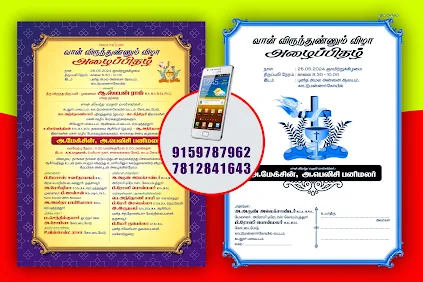vanvirunthu | holy | juses | cross |
Vanvirunthu Function:
Occasion:
Vanvirunthu is typically organized during special events such as:Weddings or significant family milestones.Religious or festival celebrations (e.g., Pongal, Deepavali).Memorial events or death anniversaries.Completion of a vow or ritual (e.g., after fulfilling religious commitments).
Guest Invitation: This function is a community-oriented gathering, and traditionally, a large number of guests are invited, often including family, friends, neighbors, and sometimes the entire village.Invitations are extended personally, and the sense of hospitality is central to the event.
Feast Menu:
The meal is typically vegetarian, although non-vegetarian vanvirunthu functions exist depending on regional or religious customs.
Traditional dishes often served include:
Rice varieties (white rice, biryani, or puliyodarai/tamarind rice).Sambar, rasam, and a variety of curries (like avial, kootu).Payasam (a sweet dish made from rice or lentils), vadai, appalam (papad).Pickles, chutneys, and side dishes made from seasonal vegetables.The food is served on banana leaves, which is a customary and eco-friendly practice.Guests are expected to sit in rows or on the floor, and food is served in courses.
Rituals and Formalities:
Before the feast begins, there may be religious rituals or prayers, particularly if the function is tied to a religious occasion or family milestone.The head of the family or host often welcomes the guests and may offer a brief word of thanks or prayer.Serving etiquette is important, with servers ensuring that all guests are well-fed and satisfied.
Cultural and Social Significance:
The vanvirunthu function is more than just a meal; it is a symbol of generosity and hospitality.It reinforces social bonds within the community, as people come together to share food and engage inconversation.For hosts, it is a way to showcase their hospitality and offer respect to their guests, while for attendees, it reflects community unity and solidarity.
Decorations and Setup:
Depending on the occasion, the venue may be decorated with traditional elements such as kolams (decorative floor patterns), flowers, and festive lighting.The eating area is arranged with long mats or tables where guests can sit comfortably while being served.In essence, vanvirunthu functions represent the heart of Tamil hospitality and are steeped in tradition, often acting as an event that brings the community together to share food, joy, and togetherness.









0 Comments
thank you for watching